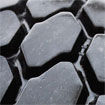
Tires: Handy Facts
- Ninety-five percent of the energy consumed during a tire’s lifecycle is consumed while in use on a vehicle (CEC, 2003)
- Between 10 and 20 percent of the energy created in a vehicle engine is used to turn the wheels. One-third of this energy is lost due to rolling resistance. (NAS, 2006)
- Each 1-psi drop in a typical light-duty tire’s pressure increases rolling resistance by 1-2 percent (NAS, 2006)
- Replacement tires with low rolling resistance (LRR) can reduce a vehicle’s fuel consumption by 2 to 6 percent compared with conventional tires (NRDC, 2004)
- LRR tires come standard on most new vehicles, since this helps automakers improve the fuel economy rating of their vehicles, but are not typically manufactured or marketed as replacement tires (CEC, 2003)
- In 2003, Ecos Consulting tested rolling resistance of 51 different tire models in four sizes, and concluded that a rolling resistance coefficient (RRC) of less than 0.0105 could be considered low rolling resistance (Green Seal, 2003)
- The 2007 Energy Bill requires the federal government to develop rules within two years for tire efficiency reporting by manufacturers (GPO, 2007). Actual reporting will not likely begin until a year or two after the rules are released.
- The Society of Automotive Engineers testing procedure, SAE J1269, is the preferential method for measuring tire rolling resistance (CEC, 2007)
- 7 to 8 gallons of oil are required to manufacture a new light-duty vehicle tire, while a retread tire only requires 2 to 3 gallons (ITRA, 2001)
- If the retread market for light-duty vehicles were fully developed, millions fewer new replacement tires would be purchased each year (EPA, 2005)
- Light-duty vehicles in the U.S. have roughly 4.5 ounces of lead clipped onto tires for wheel balancing (EPA, 2007)
- Around 2,000 tons of lead is dropped onto U.S. roadways every year as wheel weights fall from vehicle tires, mostly in urban environments due to poor road conditions and less fluid driving styles (e.g., potholes, more turns, more stops and starts) (USGS, 2006)
- Alternatives to lead wheel weights include weights made from steel, zinc, copper, tin, and plastic/PVC (Ecology Center, undated)
- In 2003, approximately 290 million scrap tires were generated in the U.S. with over 230 million of these tires absorbed into the scrap tire market and the remaining 60 million tires disposed of in landfills and other locations (EPA, undated(a))
- About 80 percent of waste tires are currently recycled or reused, compared to about 11 percent in 1990 (NAS, 2006)
- Roughly half of fleet managers in the U.S. dispose of their lead wheel weights by sending them directly to smelters or other recyclers; although at least 4,000 tons worth of disposed lead wheel weights are unaccounted for each year in the U.S. (USGS, 2006)
 |
This work by the Responsible Purchasing Network is licensed under a Creative Commons Attribution-Noncommercial-No Derivative Works 3.0 United States License. |
Feedback on this Guide
Please contact us with corrections, additions, policies, or questions.
![]() Submit Feedback
Submit Feedback


